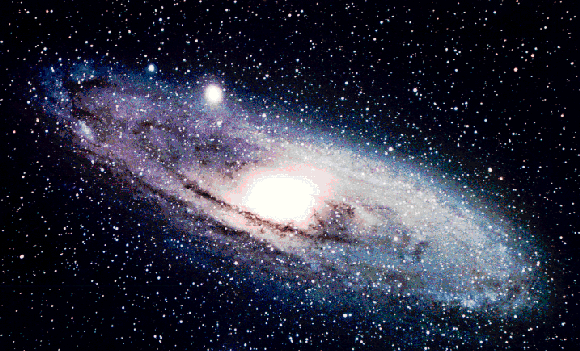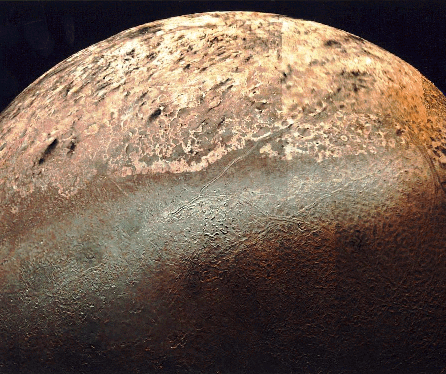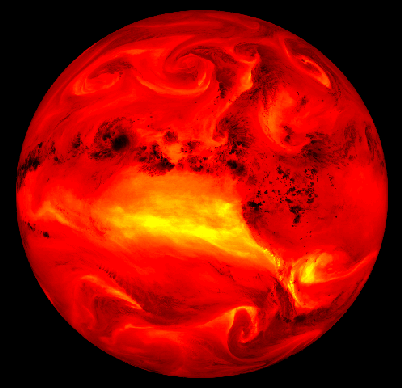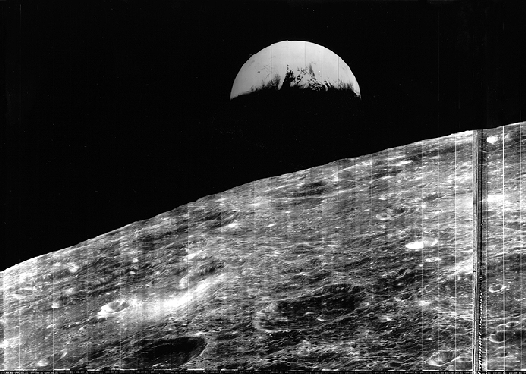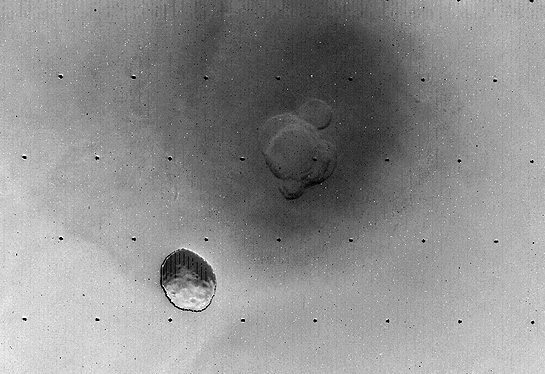NASA APOD #478-486
#478 M31: The Andromeda Galaxy October 09, 1996
“Andromeda is the nearest major galaxy to our own Milky Way Galaxy. Our Galaxy is thought to look much like Andromeda. Together these two galaxies dominate the Local Group of galaxies. The diffuse light from Andromeda is caused by the hundreds of billions of stars that compose it. The several distinct stars that surround Andromeda's image are actually stars in our Galaxy that are well in front of the background object. Andromeda is frequently referred to as M31 since it is the 31st object on Messier's list of diffuse sky objects. M31 is so distant it takes about 2 million years for light to reach us from there. Much about M31 remains unknown, including why the center contains two nuclei. "
Copyright: Jason Ware
#479 Triton: Neptune's Largest Moon October 10, 1996
“Today marks the 150th anniversary of the discovery of Triton. On October 10 1846, William Lassell was observing the newly discovered planet Neptune. He was attempting to confirm his observation, made just the previous week, that Neptune had a ring. But this time he discovered that Neptune had a satellite as well. Lassell soon proved the ring was product of his new telescope's distortion, but the satellite Triton remained. The above picture of Triton was taken in 1989 by the only spacecraft ever to pass Triton: Voyager 2. Voyager 2 found fascinating terrain, a thin atmosphere, and even evidence for ice volcanoes on this world of peculiar orbit and spin. Ironically, Voyager 2 also confirmed the existence of complete thin rings around Neptune - but these would have been quite invisible to Lassell! "
Copyright: Public domain
#480 The Double Nucleus of M31 October 11, 1996
“The center of M31 is twice as unusual as previously thought. In 1991 the Planetary Camera then onboard the Hubble Space Telescope pointed toward the center of our Milky Way's closest major galactic neighbor: Andromeda (M31). To everyone's surprise, M31's nucleus showed a double structure. The nuclear hot-spots are quite close together when considering Galactic distances: M31 is about 150,000 light years across while the above shows only the central 30 light-years. Subsequent ground-based observations have led to speculation that indeed two nuclei exist, are moving with respect to each other, that one nucleus is slowly tidally disrupting the other, and that one nucleus may be the remains of smaller galaxy "eaten" by M31. The nuclei of many galaxies, including M31, are known to be quite violent places, and the existence of massive black holes are frequently postulated to explain them. "
Copyright: Public domain
#481 The Water Vapor Channel October 12, 1996
“What alien planet's bizarre landscape lurks below these fiery-looking clouds? It's only Planet Earth, of course -- as seen on the Water Vapor Channel. Hourly, images like this one (shown in false color) are brought to you by the orbiting GOES 8 satellite's multi-channel imager. This instrument can produce images at the infrared wavelength of 6.7 microns or about 10 times the wavelength of visible light, recording radiation emitted by water vapor in the upper troposphere. Bright regions correspond to high concentrations of water vapor while dark spots are relatively dry areas. Atmospheric water vapor is invisible to the eye and produced by evaporation from the oceans. Convected upward in the tropical zones it affects the climate by contributing substantially to the greenhouse effect."
Copyright: Public domain
#482 The Earth Also Rises October 13, 1996
“The Lunar Orbiter 1 spacecraft was launched in 1966 to map the lunar surface in preparation for the Apollo moon landings. NASA's plucky robotic explorer performed its job well and pioneered this classic view of the Earth poised above the lunar horizon. The first humans to directly witness a similar scene were the Apollo 8 astronauts. As they orbited the Moon in December of 1968 they also recorded Earth rise in a photograph that was to become one of the most famous images in history - a moving portrait of our world from deep space."
Copyright: Public domain
#483 Bright Stars, Dim Galaxy October 14, 1996
“These two clusters of bright, newly formed stars surrounded by a glowing nebula lie 10 million light years away in the dim, irregular galaxy cataloged as NGC 2366. The Hubble Space Telescope image shows that the youngest cluster, the bottom one at about 2 million years old, is still surrounded by the gas and dust cloud it condensed from, while powerful stellar winds from the stars in the older cluster at the top (4-5 million years old), have begun to clear away its central areas giving the entire nebula an apparent hook shape. Compared to the sun, the stars in these clusters are massive and short lived. The brightest one, near the tip of the hook, is a rare Luminous Blue Variable with 30 to 60 times the mass of the sun - similar to the erruptive Eta Carina variable in our own Milky Way. Stars this massive are extremely variable. A comparison with ground based images indicates that in three years this star's brightness increased by about 40 times making it currently the brightest star in this dim galaxy. Studies of such distant and diverse galaxies yield clues to the relationships of star formation and galactic evolution."
Copyright: Public domain
#484 Phobos Over Mars October 15, 1996
“Hurtling through space a mere 3,000 miles above the Martian surface, the diminutive moon Phobos (below and left of center) was imaged against the backdrop of a large shield volcano by the Viking 2 Orbiter in 1977. This dramatic picture looks down from the Orbiter's viewpoint about 8,000 miles above the volcano, Ascraeus Mons. Phobos itself is 5,000 miles below the Orbiter. North is toward the top with the Sun illuminating the scene from the South (black dots are reference marks). For scale, Ascraeus Mons is about 200 miles across at its base while asteroid sized Phobos is about 15 miles in diameter. In this spectacular moon-planet image, volcanic calderas (craters) are visible at the summit of Ascraeus Mons -- while impact craters on the sunlit side of Phobos' surface can also be seen!"
Copyright: Public domain
#485 SN 1006: Pieces of the Cosmic Ray Puzzle October 16, 1996
“Research balloon flights conducted in 1912 by Austrian physicist Victor Hess revealed that the Earth was constantly bombarded by high energy radiation from space - which came to be called "Cosmic Rays". What are Cosmic Rays and where do they come from? They are now known to be mostly subatomic particles - predominantly protons and electrons - but their origin is a long standing mystery. After almost a century of study, this cosmic puzzle may have been at least partially solved by new X-ray images and spectra from the ASCA satellite observatory. Pieced together to show the region around a star observed to go supernova in 1006 AD, the overlapping X-ray snapshots above (seen in false color) reveal the bright rims of the exploded star's still expanding blast wave. These ASCA observations show for the first time that the energy spectrum of the bright regions is like that produced by extremely high energy electrons streaming through a magnetic field at nearly the speed of light. If (as expected) high energy protons are associated with these energetic electrons then supernova remnants like SN 1006 are sources of Hess' puzzling Cosmic Rays."
Copyright: Public domain
#486 Proplyds: Infant Solar Systems? October 17, 1996
“Are planets common in our galaxy? Strong evidence that the answer is "yes" was provided in this 1994 image made by the Hubble Space Telescope . A close-up of the Orion Nebulae, it reveals what seem to be disks of dust and gas surrounding newly formed stars. These fuzzy blobs, called "proplyds", appear to be infant solar systems in the process of formation. Of the five stars in this field which spans about 0.14 light years, four appear to have associated proplyds - three bright ones and one dark one seen in silhouette against the bright nebula. A more complete survey of 110 stars in the region found 56 with proplyds. If extra-solar planetary systems are common place, are there extra-terrestrial civilizations out there as well?"
Copyright: Public domain
Upvote! Resteem! Comment! As you like it! Thank you for attention!
